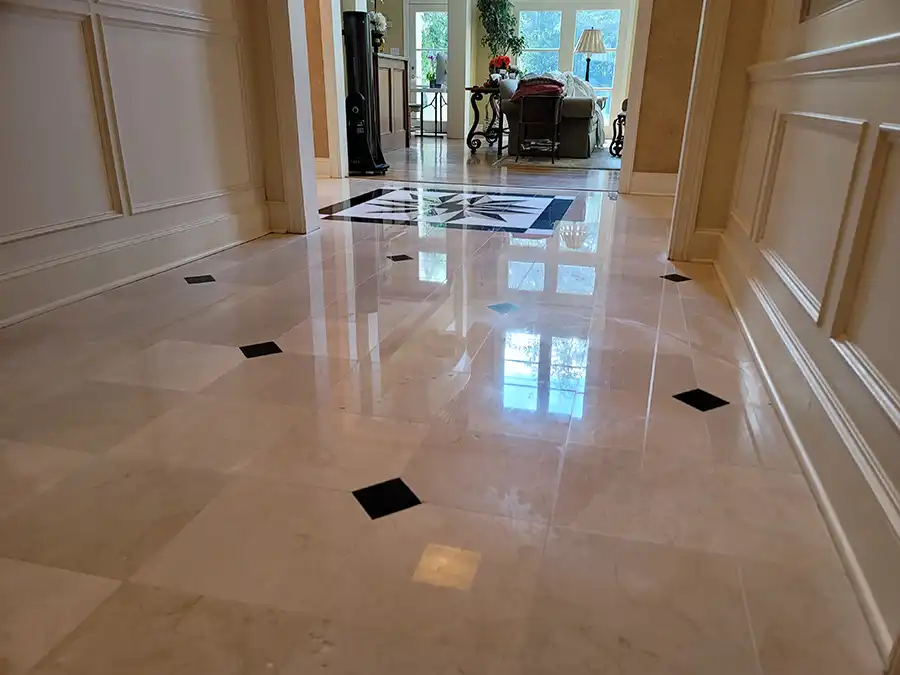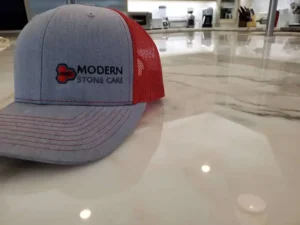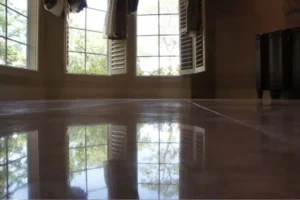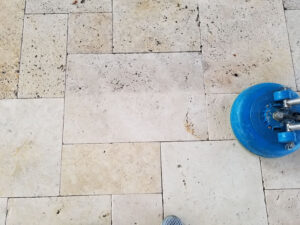Modern Stone Care in Houston specializes in the care and maintenance of natural stone surfaces. Our expertise spans across various types of natural stone, including granite, marble, limestone, and more, ensuring that these beautiful materials maintain their allure and integrity over time. Natural stone, with its timeless beauty and durability, is a popular choice for both residential and commercial spaces. It adds a touch of elegance and sophistication that few other materials can match.
However, maintaining the pristine condition of natural stone requires more than just regular cleaning; it necessitates a proper maintenance regime that includes regular resealing. In this blog post, we will explore the reasons why natural stone needs to be resealed regularly. We’ll look at the properties of natural stone, what deteriorates its sealant, how to tell when resealing is necessary, and how often it should be done. Understanding these aspects will help ensure that your stone surfaces continue to look spectacular year after year.
Understanding Natural Stone and Its Properties
Natural stone is not just chosen for its aesthetic appeal but also for its durability and longevity. However, the key to maintaining these qualities lies in understanding the inherent properties of the stone. Natural stone such as granite, marble, limestone, and slate has unique characteristics that make each type distinct.
Porosity: One of the most critical properties of natural stone is its porosity, which refers to the stone’s ability to absorb liquids. The higher the porosity, the more susceptible the stone is to staining and water damage. For example, marble is more porous than granite, making it more likely to absorb spills and stain if not properly sealed.
Absorbency: Linked closely with porosity, absorbency affects how much and how quickly a stone can absorb spilled substances. This can lead to discoloration and deterioration over time if the stone is not adequately protected with a sealant.
Durability: While natural stone is known for its toughness, its durability can be compromised if the stone is not sealed correctly. Unsealed or poorly sealed stone can be easily scratched, chipped, or cracked, particularly in high-traffic areas.
Sealing natural stone helps to mitigate these issues by providing a protective barrier that minimizes the stone’s porosity, enhances its resistance to spills, and maintains its aesthetic appeal. Next, we will delve into the purpose of sealing natural stone and how it benefits the longevity and beauty of these surfaces.
The Purpose of Sealing Natural Stone
Sealing is a fundamental aspect of natural stone care that plays a crucial role in preserving the beauty and extending the lifespan of these surfaces. Understanding why sealing is necessary can help property owners make informed decisions about their stone care routines.
Protection Against Stains: The primary function of a sealant is to protect the stone from stains. Natural stone, especially types like marble and limestone, is inherently porous, which means without a protective barrier, liquids like wine, oil, and water can penetrate the surface, leading to unsightly stains and potential damage. A sealant fills these pores, creating a barrier that prevents liquids from seeping through.
Enhancing Appearance: Sealants can also enhance the natural beauty of stone surfaces. They can bring out the colors and patterns of the stone, giving it a richer and more vibrant appearance. Certain sealants can also provide a glossy finish that many homeowners and businesses find visually appealing.
Preservation of Durability: By blocking the pores of the stone, sealants also protect it from wear and tear. This is particularly important in high-traffic areas where the stone is subjected to constant foot traffic. Sealant helps reduce the stone’s susceptibility to scratches and chips, preserving its structural integrity.
Types of Sealants: There are various types of sealants available, each suitable for different types of stone and applications. For instance, penetrating sealers soak into the stone and provide protection without changing the stone’s appearance, ideal for those who prefer a natural look. Topical sealers, on the other hand, sit on the surface of the stone, providing a glossy finish while offering strong protection against stains and scratches.
Understanding the types of sealants and their appropriate applications is crucial for effective stone care. It’s advisable to consult with a professional, such as Modern Stone Care, to determine the best type of sealant for your specific stone type and usage scenario.
Factors That Deteriorate Sealant Over Time
Sealants are not permanent; they wear down over time due to various factors, necessitating regular reapplication to maintain the stone’s protective barrier. Here are some of the common factors that contribute to the deterioration of sealants:
Physical Wear and Tear: High foot traffic can gradually wear away the sealant, especially in commercial settings or busy areas of a home, like kitchens and hallways. The movement of furniture and appliances can also scratch the sealant layer, exposing the stone beneath.
Chemical Erosion: Regular cleaning with acidic or alkaline cleaners can break down the sealant over time. Spills from acidic substances like lemon juice, vinegar, or even some cleaning products can erode the sealant if not cleaned up promptly.
Environmental Factors: Changes in humidity and temperature can cause the stone and the sealant to expand and contract, potentially cracking or flaking the sealant. Outdoor stone surfaces are particularly vulnerable to weather-induced deterioration.
Recognizing these factors and understanding how they affect the sealant can help in scheduling regular maintenance and resealing efforts to ensure the stone remains protected and beautiful.
Signs That Your Stone Needs Resealing
To maintain the integrity and appearance of natural stone, it’s vital to recognize when it needs resealing. Here are some clear signs that your stone surfaces might require attention:
Visual Cues: The first and most obvious signs are visual changes. If your stone starts to look dull or its color seems faded, it might be because the sealant has worn off, and the stone is exposed. Stains that were previously repelled may now begin to penetrate the stone, indicating that the sealant is no longer effective.
Water Absorption Test: An easy way to check the effectiveness of your stone’s sealant is to perform a water absorption test. Simply place a few drops of water on the most used areas of the stone. If the water beads up, the sealant is still working. However, if the water seeps into the stone and darkens it, this is a clear sign that the stone needs resealing.
Frequency of Maintenance: Different stone types and their locations affect how often they need to be sealed. For example, a marble bathroom countertop may require more frequent resealing than a granite floor in a low-traffic area because of its exposure to more acidic substances and higher levels of humidity.
These indicators help in determining when to reapply sealant, ensuring that your natural stone remains protected against damage and degradation. Regular checks and maintenance can extend the life of both the stone and its sealant.
The Process of Resealing Natural Stone
Resealing natural stone is a meticulous process that, when done correctly, restores its protective layer and enhances its appearance. Here’s how professionals like those at Modern Stone Care undertake this process:
1. Cleaning: The first step in resealing is thoroughly cleaning the stone to remove any dirt, debris, or residues that might prevent the sealant from adhering properly. This includes a detailed cleaning with pH-neutral cleaners that are safe for natural stone.
2. Repair: Before resealing, any chips, cracks, or other damage should be repaired. This step ensures that the sealant can uniformly cover the entire surface without gaps.
3. Application of Sealant: The type of sealant chosen depends on the stone’s type and the owner’s preference for finish (matte, glossy, etc.). The sealant is applied evenly across the surface, using tools that ensure a consistent coat.
4. Curing: After application, the sealant needs time to cure, which can vary from a few hours to a full day, depending on the product used. During this time, the stone should not be used.
5. Testing: Once the sealant has cured, it’s important to test its effectiveness (e.g., the water absorption test) to ensure that the stone is adequately protected.
This process, especially when carried out by professionals, not only prolongs the life of the stone but also maintains its aesthetic value.
How Often Should Natural Stone Be Resealed?
The frequency of resealing depends on several factors, including the type of stone, its location, and usage. Here are some general guidelines:
High Traffic Areas: Stone floors in high-traffic areas might need to be resealed annually.
Kitchens and Bathrooms: Surfaces in kitchens and bathrooms should be resealed every 6 to 12 months due to their exposure to oils, acids, and moisture.
Less Used Areas: Stone in less frequently used areas might only need resealing every two to three years.
It’s important to tailor the resealing schedule to your specific circumstances and stone type. Consulting with stone care professionals like Modern Stone Care can provide tailored advice based on an assessment of your stone’s condition and usage patterns.
Protecting Your Investment: The Importance of Regular Stone Resealing
Regular resealing is crucial to maintaining the beauty and longevity of natural stone surfaces. By understanding when and how often to reseal, you can protect your investment and keep your stone looking as beautiful as the day it was installed. For expert advice and professional stone care services, don’t hesitate to reach out to Modern Stone Care in Houston.
Modern Stone Care
970 Bunker Hill Rd
Houston, TX 77024
(832) 814–2041
View our Google Business Listing
View our Facebook Page







